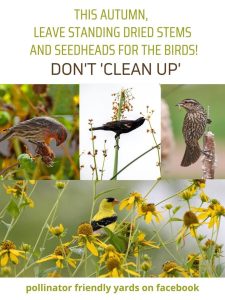
Feathered Friends in Fall: Making Your Garden a Bird Haven Leave a comment
As the amber hues of autumn paint our landscapes, and the air turns crisp and cool, our gardens transition from summer’s vibrant bloom to a more subdued, yet equally enchanting, phase. While many of us might be tempted to tidy up every fallen leaf and dried stem, there’s a compelling reason to resist: our feathered friends. Let’s explore the bird-friendly tasks we can undertake in our fall gardens to ensure our avian visitors have a cozy and nourishing stay during the colder months.
1. Embrace the Beauty of Seedheads and Dried Stems
While dried stems and seedheads might not have the same visual appeal as summer’s blossoms, they possess a rustic charm. More importantly, they’re a veritable feast for birds:
- Natural Bird Feeders: Plants like coneflowers, sunflowers, and black-eyed Susans leave behind seedheads that birds adore. By leaving these intact, you’re essentially setting up natural bird feeders throughout your garden.
- Shelter from the Cold: Thick stems and dense seedheads also provide birds with sheltered spots to perch, away from the winter winds.
2. Resist the Rake – At Least in Some Areas
While a carpet of fallen leaves might seem messy to us, it’s a treasure trove for birds:
- Bug Buffet: Leaves are a haven for insects. By leaving a patch of leaves undisturbed, you’re providing birds with a rich source of protein.
- Natural Mulch: As these leaves decompose, they’ll enrich your soil, ensuring a healthier garden in spring.
3. Set Up Bird Baths and Keep Them Clean
Fresh water can be hard to come by in colder months:
- Regular Refills: Ensure your bird baths are filled, even in colder weather. Birds need fresh water for drinking and bathing.
- Break the Ice: If the water freezes, gently break the ice or pour warm water over it. Avoid using chemicals or salt to melt the ice.

4. Consider Adding a Bird Feeder
If your garden doesn’t have many seed-bearing plants:
- Variety is Key: Different birds prefer different seeds. A mix of sunflower seeds, millet, and peanuts can attract a diverse range of birds.
- Cleanliness: Ensure the feeder is clean to prevent the spread of diseases among birds.

5. Create Cozy Shelter Spots
- Pile Up: Create a few brush piles using fallen branches and twigs. These can serve as sheltered spots for birds to roost.
- Nest Boxes: If you have nest boxes, give them a clean and ensure they’re in good condition. While they’re primarily used during the breeding season, many birds seek refuge in them during colder months.
In Conclusion
As gardeners, our role extends beyond tending to plants. Our gardens are ecosystems, teeming with life. By undertaking these bird-friendly tasks in fall, we’re not just cultivating a space for plants to thrive, but also creating a sanctuary for our feathered friends. So, the next time you spot a dried seedhead swaying in the breeze, remember the flurry of wings it’ll attract and the joyous bird songs that will serenade your winter mornings. Happy bird-watching!








